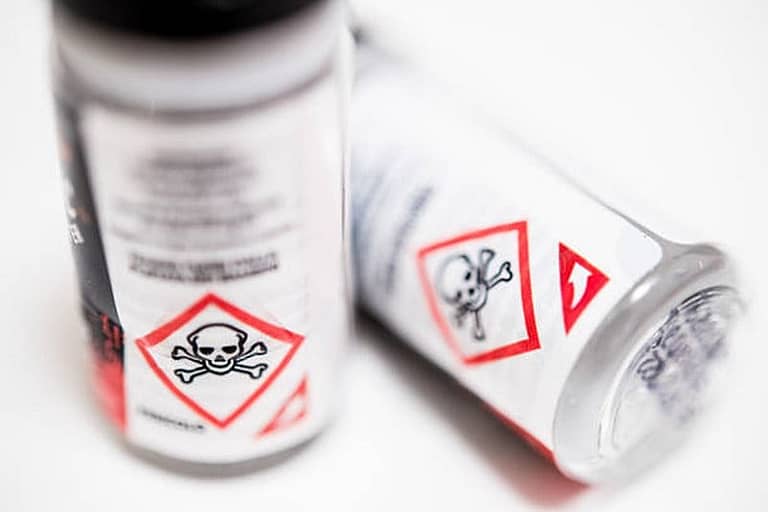The third full week in March each year is National Poison Prevention Week. This event is sponsored by the Health Resources and Services Administration (HRSA), and is dedicated to raising awareness about poison prevention and highlighting the dangers of poisoning both at home and in the workplace.
One chemical of particular concern related to workplace poisonings is hydrofluoric acid (HF). HF is an extremely corrosive acid used for many purposes including mineral digestion, surface cleaning, etching, and biological staining. HF is not your “usual acid”! Its unique properties make it significantly more hazardous than other acids. This chemical has a high degree of acute toxicity as defined in the OSHA Hazard Communication Standard and OSHA Lab Standard. The health effects of HF are dependent on the route and length of time of exposure as well as the concentration.
Eye and Skin Exposure
HF is corrosive and readily destroys tissue. Exposure to the eyes can result in permanent visual defects and blindness. HF readily penetrates human skin and can destroy soft tissues and decalcify bone. Chemical burns from HF are typically very painful and slow to heal. Not only can skin contact cause burns, but systemic fluoride poisoning can result. Even small splashes of concentrated HF on the skin can be fatal.
What makes skin exposure of particular concern is that exposure to lower HF concentrations may not produce pain or burning until hours after the exposure. By the time symptoms are noticed, serious tissue damage may have occurred.
Inhalation Exposure
Inhaling HF vapors can cause serious lung damage. Delayed effects including pulmonary edema may not be apparent until hours after exposure. To help protect against adverse effects from exposure to HF, the Occupational Safety and Health Administration (OSHA) has established a permissible exposure limit (PEL) of 3 ppm averaged over an 8-hour work shift. Other agencies, including the American Conference of Governmental Hygienists (ACGIH), have developed lower exposure limits. The ACGIH Threshold Limit Value (TLV) is 0.5 ppm.
Airborne HF concentrations of 10-15 ppm will irritate the eyes, skin, and respiratory tract. Concentrations of 30 ppm are considered “Immediately Dangerous to Life and Health” (IDLH) and may have irreversible health effects. At airborne concentrations above 50 ppm, even brief exposure may be fatal.
Ingestion
Ingesting HF can cause serious damage to the esophagus and stomach. Symptoms include burns to the mouth and throat causing severe pain, breathing difficulty, and irregular heartbeat. Swallowing even a small amount of concentrated hydrogen fluoride will affect major internal organs and may be fatal.
Exposure Control
HF should be used with adequate ventilation to minimize inhalation of vapor. Concentrations greater than 5% should always be handled in a chemical fume hood.
To prevent eye exposure, chemical goggles and a face shield should be used when handling concentrated HF. Due to HF’s highly corrosive nature, safety glasses with side shields do not provide adequate eye protection.
To prevent skin exposure, a lab coat with cuffed sleeves should be worn along with two pairs of nitrile gloves. For larger volumes, an acid-resistant apron and sleeve protectors are recommended. In addition, medium or heavy weight viton, nitrile, or other HF-resistant gloves must be worn. A second pair of nitrile exam gloves can be worn under the outer gloves for protection against leaks. Hands should be washed thoroughly after handling HF.
Safe work practices MUST be followed when working with HF. These include ensuring that employees don’t work alone and that they do not eat or drink where HF is handled. Others in the lab should be notified when HF work is in progress, and access to the HF work area should be restricted. An HF-specific standard operating procedure (SOP) should be in place that employees are trained on.
Exposure Response
Immediately call 911 if an exposure to HF occurs. All HF exposures should receive immediate medical evaluation, even if they appear to be minor. While waiting for medical help to arrive:
For an eye exposure, eyes should be immediately flushed with water for at least 15 minutes followed by a medical evaluation.
For skin exposures, any clothing that may have HF on it should be removed; cutting off clothing will help prevent skin contamination. The skin should then be flushed with water for 5 minutes and 2.5% calcium gluconate gel, a topical antidote for HF, should be messaged into the skin (using gloves if possible to prevent secondary exposure). It should be reapplied every 10 to 15 minutes while waiting for medical help. (Note that if there is no calcium gluconate available, the skin should be flushed for at least 15 minutes.)
Calcium gluconate works by combining with HF to form insoluble calcium fluoride, thus preventing the extraction of calcium from tissues and bones. Tubes of calcium gluconate gel should be kept close to the HF use area. Calcium gluconate has a limited shelf life and should be replaced with a fresh supply before its expiration date.
For an inhalation exposure, the person should be removed from the source of the exposure and moved to fresh air. Seek immediate medical attention. If someone has ingested HF, do NOT induce vomiting. call Poison Control at 1-800-222-1222. Drinking water and Milk of Magnesia (or other fluoride binding substance) may be recommended.
For additional information on hydrofluoric acid safety and preventing workplace exposure, please contact us! For resources on poison prevention and promoting National Poison Prevention Week, visit HRSA’s website.
This blog was written by Beth Graham, Director of Quality, Research, and Training


